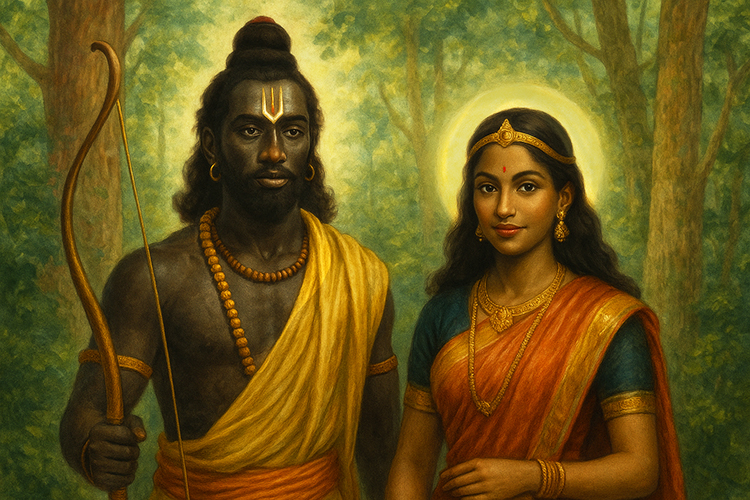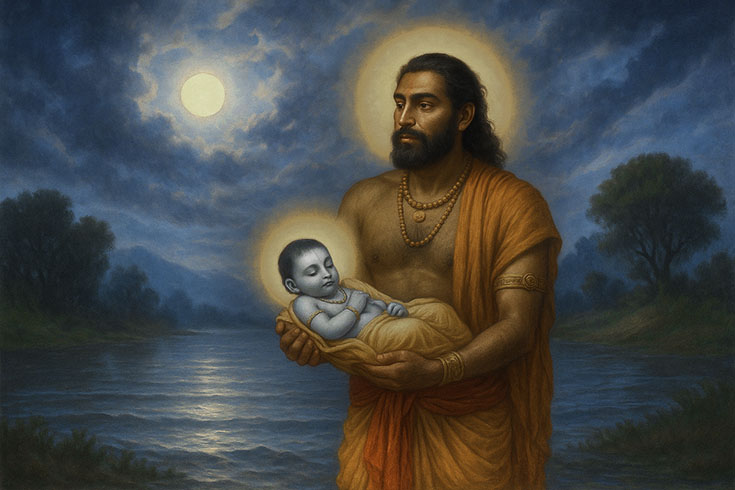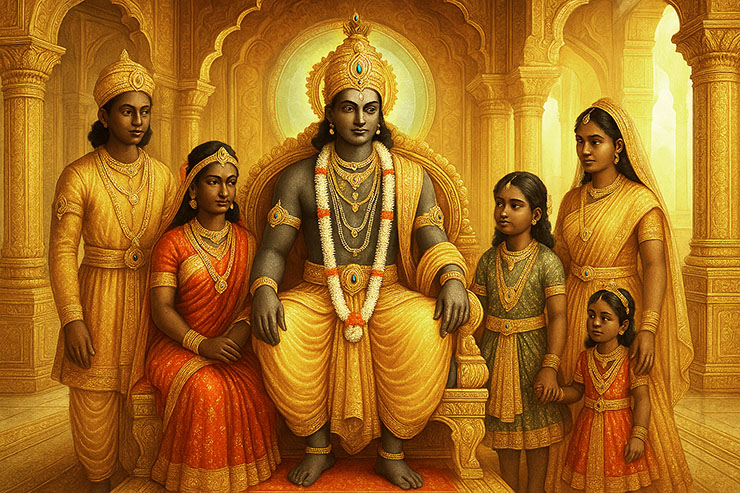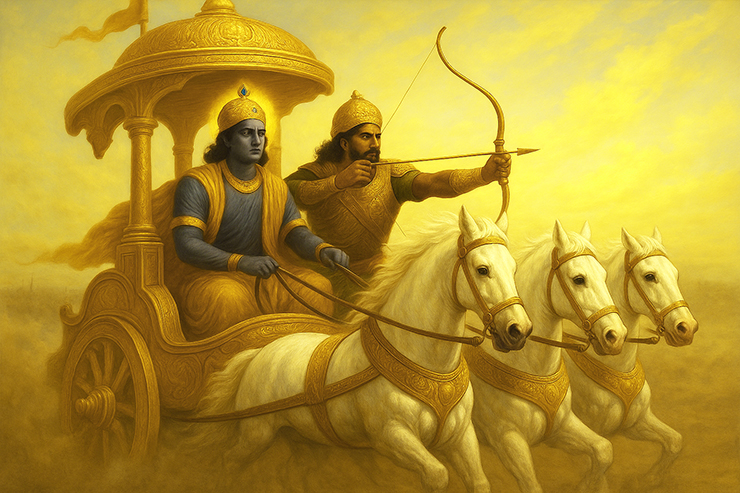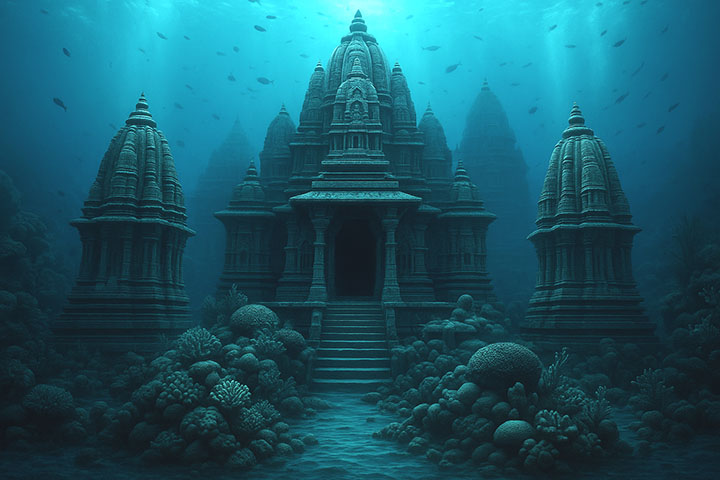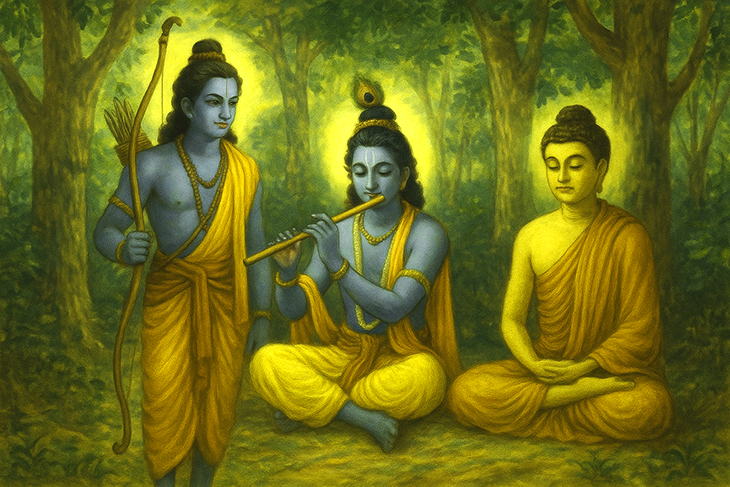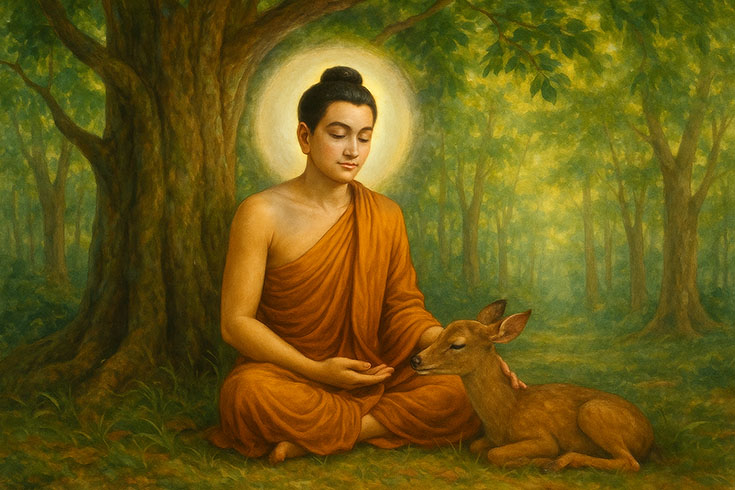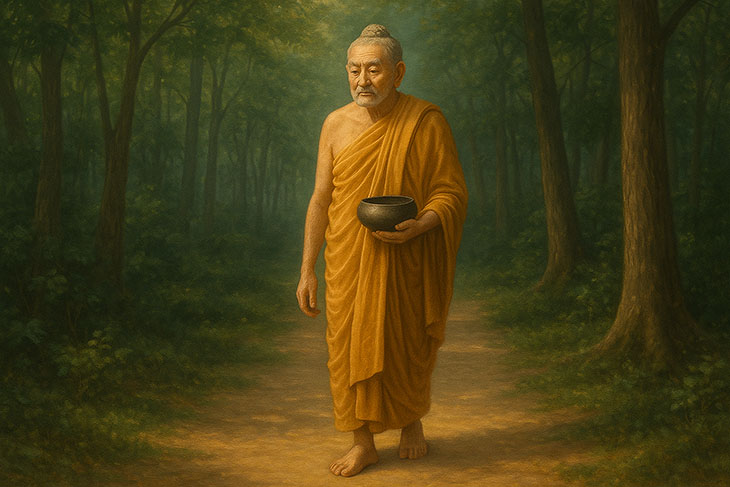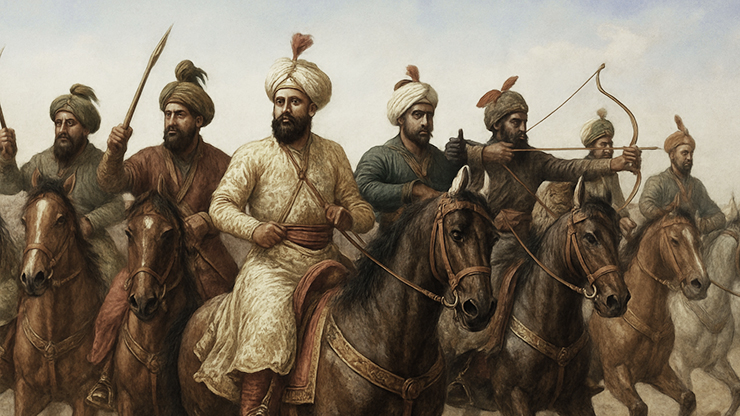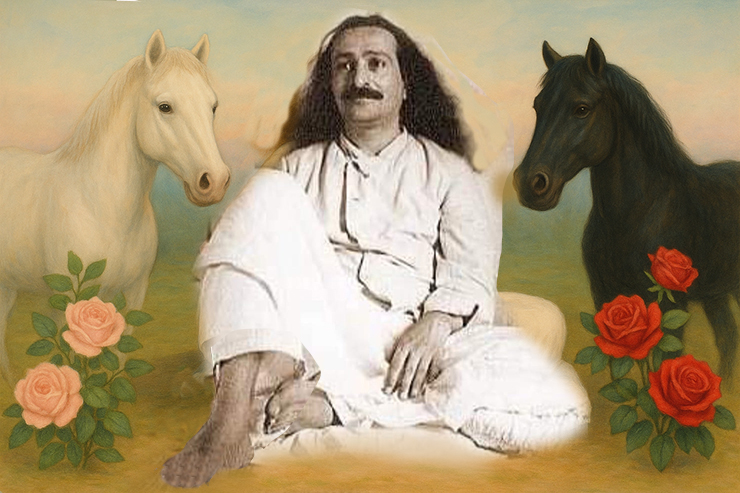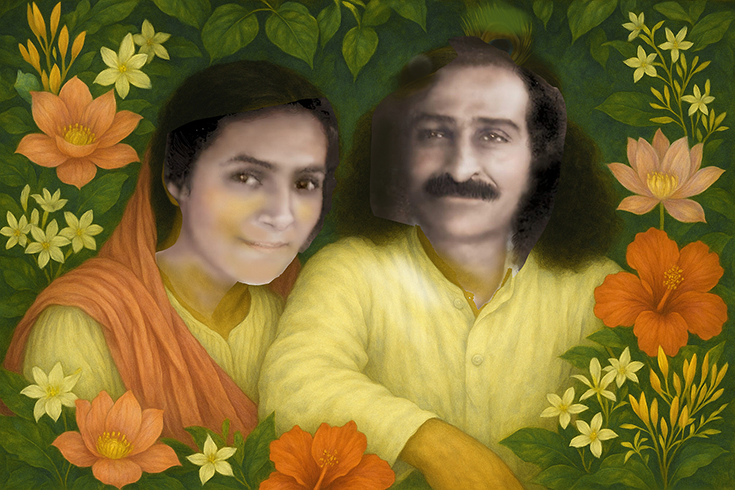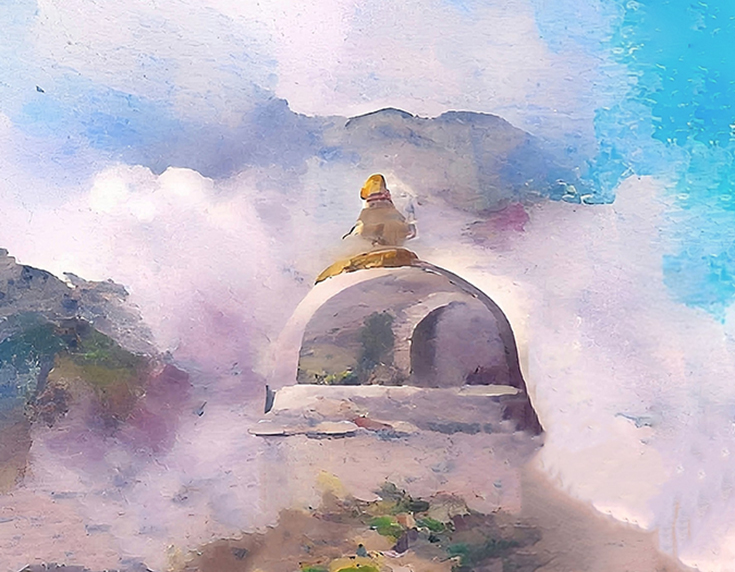Avatar Descends in India
|
Advents in India: Rama (3500 BCE), Krishna (2000 BCE), Buddha (650 BCE), Jesus (10 CE) and Meher Baba (1900 CE). This Eternally One and the Same Avatar repeats His manifestation from time to time, in different cycles, adopting different human forms and different names, in different places, to reveal Truth in order to raise humanity from the pit of ignorance. LM. The Avatar has descended, each time giving a new impulse suited to the evolving consciousness of humanity. As Rama, He came to establish dharma, the law of truth and right living, showing that obedience to divine order is the foundation of civilization. He came again as Krishna, and transformed that obedience into love, teaching that through devotion and selfless action life itself becomes a joyful offering to God. When he was Buddha, He turned humanity inward, revealing the peace that arises when desire is stilled and compassion flows toward all beings. As Jesus, He opened the heart of divine love, showing that the greatest power lies in forgiveness, humility, and self-sacrifice. And in this age, as Meher Baba, He has gathered all these truths into one living message, that God alone is real, that love and selfless service are the quickest path to Him. "Selfless service and love are twin divine qualities. Only the one who loves can serve. Serve your beloved God and you are serving your own Self in every other self." Video: Jim Meyers 'Names of Love" NAMES OF LOVE
When the Aryans migrated into India (1,500 BCE), they encountered love and devotion of Rama and Krishna. Rather than ignoring this, they gradually absorbed and refined the beliefs. The Aryans brought a structured spiritual language, the Vedic idea of cosmic law. The blending of indigenous devotion with Aryan philosophy shaped the beginnings of Hinduism, accepting Rama and Krishna as manifestations of God. Between these major avataric descents, The Avatar comes in minor incarnations, the same Infinite one, though not fully manifested. God returns, age after age, to guide His lovers towards enlightenment.. -- In India: Ram, Krishna, Buddha. Jesus and Meher Baba. - “Selfless service to humanity, without any thought of gain or reward.” Meher Baba --------------------------------------- “Rama and Krishna are not spoken of in the earliest Vedas, Their stories rise from much older Dravidian and tribal traditions. Rama The story of Rama. “Whenever there is a decline of righteousness and a rise of unrighteousness, I manifest Myself to protect the good, destroy evil, and restore dharma.”
Rama – 3,500 BCE The timeless epic of the Ramayana recounts his extraordinary journey: his unjust exile into the forest, accompanied only by his devoted wife Sita and loyal brother Lakshmana; the tragic abduction of Sita by the demon king Ravana of Lanka. In his quest, Rama forms alliance with the monkey-god Hanuman, whose boundless devotion becomes legendary. Together, with an army of vanaras (monkey warriors), Rama wages a righteous war against the forces of darkness. His victorious return to Ayodhya after fourteen years of exile—bringing Sita safely home—marks the spiritual and symbolic return of light after darkness, justice after injustice. This divine homecoming is celebrated each year during Diwali, the Festival of Lights, when lamps are lit across India to honor the triumph of good over evil and the power of love, faith, and duty. Though pure, Sita was later sent away to the forest by King Rama, a queen turned away, to preserve the honor of the throne. There she gave birth to their twin sons, Lava and Kusha. Many years passed before she stood once more before Rama. Asked again to prove her innocence, Sita’s heart, steadfast and serene, turned to the Earth, her divine mother. She called upon the ground to receive her—and the Earth opened gently, taking her home. Rama is an eternal symbol of duty and sacrifice. And Sita, in her quiet strength and unyielding truth, remains one of the most revered and radiant heroines of all time. RAM SITA EXILE page: RAM SITA EXILE The story of Rama. 3,500 BC:
AYODHYA: LORD RAMA and SITA Many fine hotels are available in Ayodhya and the nearby town of Faizabad. Be aware that most temples close for midday rest between 11 AM and 2 PM—this is a good time to enjoy lunch, take a boat ride, or explore the local bazaars. Don’t miss the new Janmabhoomi Temple, honoring the birthplace of Rama. To continue your pilgrimage, drive to Lucknow. From there, direct flights are available to Delhi or Srinagar. RAM SITA EXILE page: RAM SITA EXILE
INDIA PILGRIMAGE PAGE INDIA PILGRIMAGE ------------------------------------------------- The winter months, particularly December and January, showcase Ayodhya, Varanasi and Sarnath at their best, with clear skies and a pleasant breeze. The winter season in Ayodhya witnesses the celebration of Diwali, a festival of lights. Monsoon, from July to September, the River Ganges in Varanasi and the Sarayu River in Ayodhya can become unnavigable. --------------------------------------------- Lord Krishna LORD KRISHNA AND RADHA IN VRINDAVAN Krishna – c. 2,000 BCE Krishnas' teachings to the warrior Arjuna on the battlefield of Kurukshetra remain among the most profound spiritual discourses in world literature, exploring duty, selflessness, and the eternal soul. Under a starry sky heavy with fate, Krishna was born in the prison cell of Mathura, to Devaki and Vasudeva. He was the eighth male child — the one foretold to destroy the tyrant Kansa, Devaki’s own brother, who ruled Mathura with cruelty and dread. The moment the baby appeared, the prison doors opened, the guards fell asleep, and the river Yamuna parted to make way. Vasudeva carried his newborn son across the waters to the village of Gokul, where he was exchanged with the infant daughter of Yashoda and Nanda, the cowherd chief.
Krishna’s earliest years were marked by miracles and mischief. He crawled through cow dung, stole curds, and enchanted all with his dark-eyed smile. But even as a toddler, danger followed. Kansa, fearing the prophecy, sent demon after demon to kill the child: The giantess Putana, who tried to poison him with her breast milk, fell lifeless as Krishna sucked the very life from her. Trinavarta, a whirlwind demon, carried him into the sky — only to be crushed under the baby’s weight. Others met similar ends, undone by the divine child who seemed no more than a playful boy. At the age of three, due to growing threats, Nanda moved the entire village to the forested pastures of Vrindavan, on the other side of the Yamuna. In Vrindavan. Surrounded by forest, river, and cow-dotted meadows, Krishna grew into a radiant youth — full of laughter, grace, and boundless charm. He played the flute under the kadamba trees, and its notes stirred the hearts of all beings: None were more entranced than Radha, older than Krishna by a year or two, was the daughter of Vrishabhanu and Kirti, from the nearby village of Barsana. Her beauty was unmatched, but it was her devotion, her spiritual longing, that set her apart. In every glance she cast upon Krishna, there was recognition — not just of a boy, but of the Divine Beloved. Their love was not of the world. It was not defined by marriage or convention. They met in secret groves, danced in moonlit clearings, and played among the trees — their companionship the highest symbol of bhakti, the path of love and surrender. As he grew, Krishna became the guardian of Vrindavan He lifted Govardhan Hill on his little finger to shelter his village from Indra’s wrath. He subdued Kaliya, the many-hooded serpent who poisoned the Yamuna, dancing on its heads until it surrendered. He stole butter, teased the gopis, and laughed with Balarama, but always, there was a deeper purpose behind the play. He was showing the world how to live with joy, how to love the Divine, and how to protect the innocent — even in childhood.
KRISHNA AND BALARAMA LEAVE RADHA AND VRINDAVAN At around age seventeen, Krishna left Vrindavan and moved to Mathura The gopis wept. Radha stood silent. Krishna said nothing of his plan to return. In spirit, he and Radha remained united — beyond time, beyond place — For theirs was the love of God and the soul, eternally entwined. -------------------------- Krishna left Vrindavan and returned to Mathura, In Mathura, Krishna defeated Kansa’s wrestlers, broke free from all traps, and killed the tyrant king in the palace arena — ending the reign of fear. He freed his parents, honored the people, and began the next chapter of his mission. where he slew the evil king Kamsa. After a brief stay in Mathura, sensing danger from outside forces, Krishna led his people westward. There, on the coast of Gujarat, he founded the fortified city of Dwarka—a secure and splendid kingdom that would become the setting for many episodes of the Mahabharata.
LORD KRISHNA, QUEEN RUKMINI AND FAMILY IN DWARKA PAGE Krishna’s Life in DwarkaThe city rose from the sea, said to have been built overnight by divine architects. With golden walls, wide roads, and flowering gardens, Dwarka was both a capital of power and a haven of peace. Krishna ruled there as a prince and later king, guiding his people with wisdom and justice.
Central to the Mahabharata the great battle of Kurukshetra began over a bitter dispute between two royal families—the Pandavas and the Kauravas—over rightful rule of the kingdom. When all efforts at peace failed, including Krishna’s own attempt as a mediator, war became inevitable. Though he vowed not to fight, Krishna agreed to be the charioteer for Arjuna, the Pandava warrior, guiding him not only in battle but also in spirit — delivering the timeless teaching of the Bhagavad Gita on duty, righteousness, and the eternal soul. in the great war. On his return to Dvaraka, in a fight among the Yadava chiefs, Krishna’s brother and son were slain. As Lord Krishna sat in the forest lamenting, a huntsman, mistaking him for a deer, shot him in his one vulnerable spot, the heel, killing him. KRISHNA in DWARKA
Krishna, circa 2,000 BC. the central figure in the Mahabharata, is revered for his teachings in the Bhagavad Gita, where he imparts profound spiritual wisdom to the warrior Arjuna. His life encompasses divine playfulness, profound love, and the upholding of dharma. Krishna's kingdom in Dwarka is now believed to be submerged beneath the Arabian Sea, near the present city of Dwarka. Krishna in Dwarka PAGEThe western coastal city of Dwarka in present-day Gujarat is said to be the site of Krishna’s later kingdom—a fabled city of golden towers and glittering palaces, now believed to lie submerged beneath the Arabian Sea. According to tradition, it was in Dwarka that Krishna spent his final days. His departure from the earth marks the end of the Dvapara Yuga, fixed by tradition at 3102 BCE. A Note on Krishna’s AppearanceTradition holds that Krishna was dark-skinned, often described as the color of storm-laden clouds. His name itself—Krishna—means “dark” or “black.” The later arrival of lighter-skinned Indo-Aryan groups around 1500 BCE occurred long after Krishna’s time, making him a figure rooted in the earlier, pre-Aryan layers of Indian spiritual heritage. Krishnas' life in Dwarka KRISHNA in DWARKA Krishna Janmashtami -- A two day festival celebrating the birth of Lord Krishna. In either August or September. HOW TO VISIT: Mathura is a short train ride away from Delhi. There are many hotels, both in Mathura and Vrindavan. There is a nice hotel near the train station in Mathura. Fancier hotels are in Vrindavan. You can drive from New Delhi (3 hour drive) to Vrindavan and Mathura. You will need a few days to see the main sites, including Gokul. Start your india pilgrimage: INDIA PILGRIMAGE If you choose to go to Dwarka in western Gujarat, the journey is complicated. A train from Jamnagar is the easiest way. Jamnagar is the closest airport to Dwarka. The original Dwarka of Krishna's reign is underwater. Some people visit it with scuba. There are a couple hotels in Orcha. There are many nice hotels in Dwarka, by the sea. Closest to Dwarka, Veraval has direct plane flights from Mumbai. According to Puranic sources, Krishna's disappearance marks the end of Dvapara Yuga and the start of Kali Yuga, 3102 BCE. There is a small temple in Veraval, by the sea and rivermouth, where local people believe his body was fished out of the river and taken.
Ram Krishna Buddha. ----------------------------------------- The Light skinned Aryan pastoralists migrated from Central Asia into the Indian subcontinent around 1500 BCE, bringing with them early forms of the Indo-European languages. As they moved into northern India, particularly the Indus Valley and the Ganges Plain, the indigenous Dravidian populations gradually migrated southward. The Aryans established the foundations of the Vedic religion, a spiritual system based on the sacred hymns of the Rigveda, which later evolved into what is now known as Hinduism. ----------------------------------------------- Lord Buddha SARNATH: LORD BUDDHA SEAT The story of Buddha. 650 BC . Sarnath remained abandoned until 1834 when Alexader Cunningham excavated the site. Buddha founded Buddhism here around 700 BC. He gave his first sermon, "The Setting in Motion of the Wheel of Dharma", at Sarnath, near Varanasi. Sarnath means 'Lord of the Deer'. During the time of Gautama Buddha, Varanasi was part of the Kingdom of Kashi. Buddha (Siddhartha Gautama) preached that desire was the root cause of suffering and that people should seek to eliminate desire. Video: Mah?parinibb?na Sutta The Buddha’s First DiscourseLord Buddha was born in Lumbini and married a princess. They had a son. Buddha was awakened to his God conscious state sitting under a Bodhi tree in Ceylon (Sri Lanka). He walked from Sri Lanka to Sarnath in northern India. The Buddha said he had woken up to the truths of existence and that he was a fully enlightened one, he was fully awakened.
Buddha in his Dear Park (c. 650 BCE) Buddha established his ashram in Sarnath. He had many disciples who later traveled the world and established Buddhism in many Eastern countries. His female disciples were called nuns, who lived separately from the men. Sarnath is the place of Buddha, though many other places consider themselves important. Buddha After Sarnath After turning the Wheel of Dharma in the Deer Park at Sarnath—where he taught the Four Noble Truths and the Eightfold Path to his first five disciples—Gautama, now the Buddha, set forth on a lifelong journey to share the way out of suffering. He walked across the plains of the Ganges Valley—through Varanasi, Rajagaha, Vaishali, and Kapilavastu—always on foot, barefoot, carrying nothing but his alms bowl, speaking only when asked. He did not preach a religion but offered a method: ethical living, mindfulness, and insight into the nature of suffering, impermanence, and the illusion of self. Many who heard him left their homes to follow him—men and women, princes and laborers. The Sangha, the community of monks and nuns, was born. He returned to Kapilavastu, his homeland, where his father, King Suddhodana, still grieved his departure. His wife Yasodhara and son Rahula joined the Sangha in time, renouncing palace life for the search for truth. He spent the rainy seasons (the vassa) in monasteries or under trees, teaching and meditating. Kings such as Bimbisara and later Ajatashatru of Magadha, and the merchant Anathapindika, became patrons, building monasteries like Jetavana and Veluvana for the growing community.
The Buddha often withdrew into solitude. In forests and caves, he often stayed in seclusion. Though his teachings spread, he remained a wanderer, never claiming a permanent home. As the years passed, his body aged but his mind remained luminous. When he was around 80, he fell ill after a meal in Kushinagar. Knowing his time had come, he lay between two sal trees. ------------------------------------------------ At Sarnath now are his ruins, stupa and museum. In Sarnath every country has now built their own structures that represent their school of Buddhism. Among the several temples, monasteries and structures, Thai Temple is the most famous place of worship for the Thai Buddhists. There are also Tibetan, Chinese, Japanese temples, and more.
Video: Sarnath Attractions: Sarnath attractions to visit HOW TO VISIT: Sarnath is a mere 10 Km from Varanasi. There are flights from Delhi and elsewhere to Varanasi. You can drive from Lucknow, a 4+ hour drive. Trains arrive from all over India. There are fine hotels in Sarnath and many hotels in Varanasi, by the ghats overlooking the River Ganges. --------------------------------------------- --------------------------------------------
Lord Jesus KASHMIR: LORD JESUS Jesus of Nazareth was born in humble surroundings, traditionally in Bethlehem, and grew up in Galilee. As a young man, he was baptized by John the Baptist and began preaching a message of love, forgiveness, and the nearness of the Kingdom of God. His teachings drew large crowds, especially among the poor and outcast. He healed the sick, welcomed children, challenged hypocrisy, and taught in parables that stirred hearts. His growing influence—and his defiance of religious and political conventions—made him a target of the ruling elite. In the final days of his life, Jesus entered Jerusalem. At a Passover meal with his closest followers, he foretold his betrayal and offered bread and wine as symbols of his body and blood, a gesture that became sacred in Christian tradition. He was arrested, tried by the Sanhedrin, and brought before Pontius Pilate, the Roman governor. Pilate found no fault in him, but bowed to public pressure and sentenced Jesus to death. Jesus was tied to a cross and seemed to give up his spirit. His body was taken down and placed in a nearby tomb by a few faithful followers. About 30 AD: He revived after three days and quietly left with his closest disciples. They walked East and visited India and further East. The group of his Jewish followers, who stayed behind, slowly established Christianity. Jesus and a few close ones went to different places in India such as Rameshwaram, Dwarka, Benares and also Rangoon. Susan White painting.. susanwhiteart.com Jesus was an Essenes and they have some records of this. Many scholars and mystics have suggested that Jesus may have been closely connected with, or even trained among, the Essenes—a Jewish sect known for their ascetic lifestyle, deep spirituality, and devotion to purity and divine wisdom. The possible disciples who traveled east with Jesus after His crucifixion.
Local tradition in Pakistan—particularly in the hill station of Murree suggests Mary, the mother of Jesus, died and was buried somewhere there. Jesus (identified as Yuz Asaf), his mother Mary, and Thomas the Apostle traveled from Taxila toward Murree, where Mary died en route and was buried at a site now known as “Mai Mari da Asthan” (literally “resting place of Mother Mary”) at Pindi Point paarsurrey+9Wikipedia+9The Muslim Times+9. The site has long been revered by local Hindus and Muslims, In 1916–17, a British engineer attempted to demolish the tomb, but public outcry prevented it. The structure remains a modest cemented grave next to a television tower, guarded and maintained as a kind of shrine ------------------------------------ Nicolas Notovitch – A 19th-century Russian traveler who claimed to find Tibetan manuscripts about “Issa” (a name thought to be Jesus) living and teaching in India... The Ahmadiyya Muslim community – They hold a detailed belief that Jesus lived in India post-crucifixion and is buried in Srinagar, Kashmir. Their final destination was Kashmir, India where Jesus retired, . around 80 AD. Driving North from Srinagar, the valley of Harwan is where he was eventually buried by his close disciples, on a mountain. His tomb is in a small cave on the side of the mountain, the entrance is covered by rock slide and not to be found. Jesus buried in Kashmir page SRINAGAR JESUS ---------------------------------- HOW TO VISIT: You can easily fly to Srinagar from Delhi or from Lucknow. A train ride would be slow and difficult. There are many taxis available in Srinagar and a Tourist Center in town. Hundreds of fancy hotels and budget options are available. He was buried in north Harwan, north of Srinagar. Harwan is approximately 18 km northeast of Lal Chowk, the central commercial hub of Srinagar. A taxi from Lal Chowk or Srinagar Airport to Harwan typically takes about 50 minutes. A nearby Buddist monastery in Harwan was in use 2,000 years ago. The view from the Buddhist monastery ruins is of the mountains across the narrow valley of Harwan in Kashmir. Near hotels: 'Nadis' is a contemporary boutique hotel with 18 rooms, 'Harwan Resorts', and many more, on the east side of the lake. --------------------------------------------------- Start you India Pilgrmage: INDIA PILGRIMAGE ----------------------------------------------- Muhammad MUHAMMAD is not known to have visited India.( Muhammad is believed to have become God's prophet at the age of 40, around 610 CE, Centuries later, Muslim Invasions of the 8th, 11th, and 12th centuries gradually established Muslim rule in parts of Northern India. Islam became a major force in India, and these 2 very different religions began to clash.
The Muslim conquests in Indian subcontinent came to a halt as the British East India Company seized control of much of the Indian subcontinent. The British Raj, then lasted from 1858 to 1947, when India was partitioned into the Dominion of India and the Dominion of Pakistan. Lord Mountbatten confirmed the date for Indias' independence as 15 August 1947. Shivajis' creation of the Maharastra state 1650's SHIVAJI MAHARAJ ----------------------------------------------- AVATAR MEHER BABA ------------------------------------------------ Avatar Meher Baba - Ahilyanagar FEBRUARY 25,1894 - JANUARY 31 1969
In January 1922, Meher Baba was destined to leave Upasni Maharaj and Sakori and begin his Universal work. A few minutes before his departure, Upasni Maharaj called him into his hut and with folded hands proclaimed, “Merwan, you are Adi Shakti – the Primal Force! You are the Avatar – the direct descent of God!” Story of Meher Baba page STORY MEHER BABA .
MEHERA IRANI AND MEHER BABA Avatar Meher Baba MEHER BABA'S SAMADHI TOMB . SAMADHI VISIT
ANN LOVELL ART MEHER BABA'S SAMADHI TOMB . SAMADHI VISIT ------------------------------------------- Story of Meher Baba STORY MEHER BABA Meher Baba dictated two books: 'God Speaks' and 'The Discourses'. Elenas' Suggested Samadhi Superstructure Samadhi Superstructure.. Avatar Meher Baba Trust https://avatarmeherbabatrust.org . Story of Meher Baba page STORY MEHER BABA . SAMADHI VISIT page ------------------------------------------------------ |
||||||||||
THE FOUR STATES OF RAMA AS EXPLAINED BY MEHER BABA: https://avatarmeherbabatrust.org . AVATAR MEHER BABA TRUST WEBSITE Elenas India stories page: PERSONAL STORIES
|
Avatar Meher Baba
